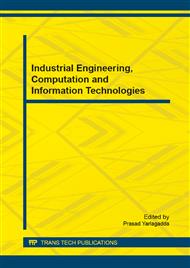[1]
T. Horprasert, D. Harwood, and L. Davis, A statistical approach for real-time robust background subtraction and shadow detection, in Proc. IEEE Frame Rate Workshop, 1999, pp.1-19.
Google Scholar
[2]
O. Javed and M. Shah, Tracking and object classification for automated surveillance, " in ECCV , 02: Proceedings of the 7th European Conference on Computer Vision-Part IV. London, UK: Springer-Verlag, 2002, pp.343-357.
DOI: 10.1007/3-540-47979-1_23
Google Scholar
[3]
K. P. Karmann, A. V. Brandt, and R. Gerl, Moving object segmentation based on adaptive reference images, in In Signal Processing V: Theories and Application. Elsevier Science Publishers B. V, (1990).
Google Scholar
[4]
B. P. L. Lo and S. A. Velastin, Automatic congestion detection system for underground platforms, in In Proceedings of 2001 International symposium on intelligent multimedia, video, and speech processing, 2001, pp.158-161.
DOI: 10.1109/isimp.2001.925356
Google Scholar
[5]
R. Cucchiara, C. Grana, M. Piccardi, and A. Prati, Detecting moving objects, ghosts, and shadows in video streams, IEEE Trans. Pattern Analysis and Machine Intelligence, vol. 25, no. 10, pp.1337-1442, (2003).
DOI: 10.1109/tpami.2003.1233909
Google Scholar
[6]
C. Wren, A. Azarbayejani, T. Darrell, and A. Pentland, Pfinder: Real-time tracking of the human body, IEEE Trans. Pattern Analysis and Machine Intelligence, vol. 19, no. 7, pp.780-785, (1997).
DOI: 10.1109/34.598236
Google Scholar
[7]
C. Stauer and W. E. L. Grimson, Learning patterns of activity using realtime tracking, IEEE Trans. Pattern Analysis and Machine Intelligence, vol. 22, no. 8, pp.747-757, (1997).
DOI: 10.1109/34.868677
Google Scholar
[8]
A. Elgammal, D. Harwood, and L. Davis, Non-parametric model for background subtraction, in ECCV 2000, LNCS 1843. Springer, 2000, pp.751-767.
DOI: 10.1007/3-540-45053-x_48
Google Scholar
[9]
N. Friedman and S. Russell, Image segmentation in video sequences: a probabilistic approach, in Proceedings of the 13th Conference on Uncertainty in Artificial Intelligence. (1997).
Google Scholar
[10]
C. Cortes and V. Vapnik, Support-vector network, Machine Learning, vol. 20, pp.273-297, (1995).
Google Scholar
[11]
H. Kim, R. Sakamoto, I. Kitahara, T. Toriyama, and K. Kogure, Robust foreground segmentation from color video sequences using background subtraction with multiple thresholds, in In Proc. KJPR, 2006, pp.188-193.
Google Scholar


